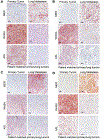Stromal changes in the aged lung induce an emergence from melanoma dormancy
- PMID: 35650435
- PMCID: PMC9554951
- DOI: 10.1038/s41586-022-04774-2
Stromal changes in the aged lung induce an emergence from melanoma dormancy
Erratum in
-
Author Correction: Stromal changes in the aged lung induce an emergence from melanoma dormancy.Nature. 2025 Feb;638(8051):E31. doi: 10.1038/s41586-025-08659-y. Nature. 2025. PMID: 39890900 No abstract available.
Abstract
Disseminated cancer cells from primary tumours can seed in distal tissues, but may take several years to form overt metastases, a phenomenon that is termed tumour dormancy. Despite its importance in metastasis and residual disease, few studies have been able to successfully characterize dormancy within melanoma. Here we show that the aged lung microenvironment facilitates a permissive niche for efficient outgrowth of dormant disseminated cancer cells-in contrast to the aged skin, in which age-related changes suppress melanoma growth but drive dissemination. These microenvironmental complexities can be explained by the phenotype switching model, which argues that melanoma cells switch between a proliferative cell state and a slower-cycling, invasive state1-3. It was previously shown that dermal fibroblasts promote phenotype switching in melanoma during ageing4-8. We now identify WNT5A as an activator of dormancy in melanoma disseminated cancer cells within the lung, which initially enables the efficient dissemination and seeding of melanoma cells in metastatic niches. Age-induced reprogramming of lung fibroblasts increases their secretion of the soluble WNT antagonist sFRP1, which inhibits WNT5A in melanoma cells and thereby enables efficient metastatic outgrowth. We also identify the tyrosine kinase receptors AXL and MER as promoting a dormancy-to-reactivation axis within melanoma cells. Overall, we find that age-induced changes in distal metastatic microenvironments promote the efficient reactivation of dormant melanoma cells in the lung.
© 2022. The Author(s), under exclusive licence to Springer Nature Limited.
Figures
















Comment in
-
Aged Lungs Enable Metastatic Outgrowth of Dormant Melanoma Cells.Cancer Discov. 2022 Aug 5;12(8):1834. doi: 10.1158/2159-8290.CD-RW2022-108. Cancer Discov. 2022. PMID: 35686835
-
The aging lung microenvironment awakens melanoma metastases.Cancer Cell. 2022 Aug 8;40(8):815-817. doi: 10.1016/j.ccell.2022.06.013. Epub 2022 Jul 21. Cancer Cell. 2022. PMID: 35868308
References
MeSH terms
Substances
Grants and funding
- T32 CA009071/CA/NCI NIH HHS/United States
- R50 CA211199/CA/NCI NIH HHS/United States
- P50 CA174523/CA/NCI NIH HHS/United States
- R01 CA207935/CA/NCI NIH HHS/United States
- P30 CA010815/CA/NCI NIH HHS/United States
- R50 CA221838/CA/NCI NIH HHS/United States
- R00 CA208012/CA/NCI NIH HHS/United States
- P01 CA114046/CA/NCI NIH HHS/United States
- P50 CA261608/CA/NCI NIH HHS/United States
- R01 CA174746/CA/NCI NIH HHS/United States
- R01 CA232256/CA/NCI NIH HHS/United States
- U01 CA227550/CA/NCI NIH HHS/United States
- P30 CA00697356/NH/NIH HHS/United States
- K01 CA245124/CA/NCI NIH HHS/United States
LinkOut - more resources
Full Text Sources
Medical
Research Materials
Miscellaneous

